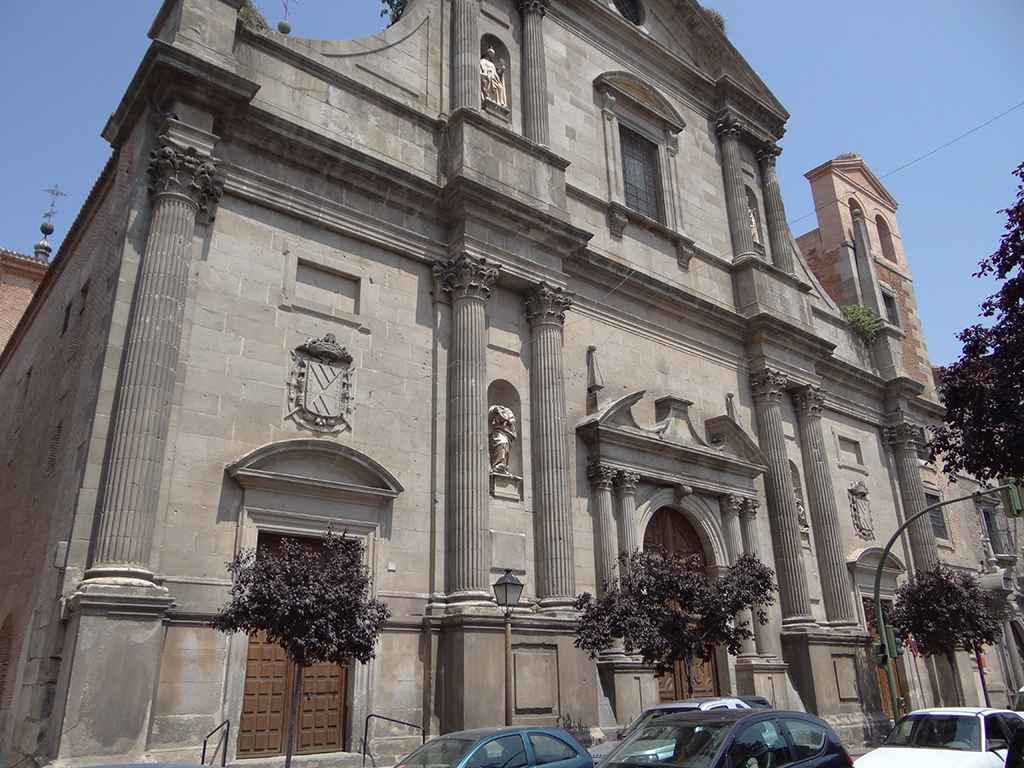Next to the Jesuit institution Colegio Máximo and as part of it, the Santa María la Mayor Church—with the Alcalá’s most monumental façade after that of the University—is placed.
Into the building of Santa María la Mayor Church, the façade and chapels stands out. Among these chapels, the renovated chapel of Santas Formas is dedicated to the miracle of the incorruptible collection of consecrated wafers.
Its construction started at 1567, but after three years, the works were stopped due to economic problems that were solved thanks to María and Catalina de Mendoza donations. Bartolomé de Bustamante’s father designed the building, and its construction was leaded by the architects Francisco de Mora and his nephew Juan Gómez de Mora, who finished it in 1620 and its façade five years after.
Jesuit model of architecture
The style of the Santa María la Mayor Church followed the strict and new architectonic concepts dictated by the Council of Trent, where the old and new were merged conferring great importance to the faithful meeting place—which symmetrical shape and good acoustics.
The prime example of Society of Jesus temples was the Church of the Gesù in Rome, and the typical model of that style in Spain, within seventeenth and eighteenth century, is precisely the Jesuit church in Alcalá. Currently, the Jesuit church has been replaced by the Santa María la Mayor Church—which, until a fire in 1936, was situated at Plaza de Cervantes.
An impressive façade
The Santa María la Mayor Church impressive façade comprises giant double columns with several relevant images. While in the upper part Saint Ignatius of Loyola and Saint Francis Xavier are represented, in the lower part images of Saint Peter and Saint Paul are sculpted, all of them by the Portuguese Manuel Pereira. Over the arch pediments, the two Mendoza’s coats of arms can be appreciated.
A feeling of greatness is breathed in the inside of Santa María la Mayor Church transmitted through its dimensions—both main floor and side chapels—and the height of the dome. The main altarpiece and its splendid monstrance attract attention and show the transition style to Herrerian Baroque.
The miracle of the Santas Formas
The entrance to Santas Formas chapel is placed inside Santa María la Mayor Church. The chapel put up in 1718 and restored in 2011, was named commemorating the miracle of the twenty-four consecrated wafers that never rot and whose history—full of ups and downs—, took place at the end of sixteenth century (read more). Important mural paintings of Juan Vicente de la Ribera, dating back from 1699, are kept.
The miracle happened on May 1st, 1597, when a Moorish stole twenty-six figures from a church and, regretting it, confessed his sins to the Jesuit father Juan Juárez—in the church placed where after the actual Jesuitas or Santa María la Mayor Church would be constructed.
The wafers were not used in any mass for fear of them being poisoned—which had already happened before—but they were not destroyed because, as they were already consecrated, it might has been considered disrespectful. As a result, they were kept in a small silver box, waiting them to rot; moment in which they could be finally threw out.
Notwithstanding, they did not rot at all, and after test them in different ways, the miracle of their incorruptibility was proclaimed in 1619. Since that moment, its popular worship was spread, with the total approval of ecclesiastical authorities who proclaimed all sorts of papal indulgences and established their own feast, set up the fifth Sunday after Resurrection, in the middle of May.
Charles III, Joseph Bonaparte and Alfonso XII visits
The Santas Formas worship reached such a magnitude since the miracle was known that when wafers were kept into the Jesuit church—into the newly-made chapel—, a great procession was celebrated. The King Philip III and his wife the Queen Margaret of Austria—along with every civil and religious authorities of Alcalá—attended to the procession, winding solemnly its way through the city streets, adorned with hanging tapestries celebrating that occasion.
In 1777, the Santas Formas were moved to the Magisterial Cathedral and the faithful showed up in such quantity that their assistance had to be controlled. Also numerous monarchs went to worship, such as Charles II, Charles III (in 1759), Joseph Bonaparte (who in 1810 was claimed to have donated a ring set on top of the cross where Santas Formas were kept), Ferdinand VII (in 1816), Alfonso XII and the Queen Maria Christina (in 1880).
With the fire of the Magisterial Cathedral in 1936, the Santas Formas and its custody disappeared. After the war, the celebration of the miracle ceased, even though it was the most important and popular festivity of Alcalá, even more than Saints Children, Virgin of the Val, or the festivities of the end of August.
Additional information:
- www.catedraldealcala.org
- dspace.uah.es
- www.lacallemayor.net
- cvc.cervantes.es
- www.alcalavirtual.es
- “Leyendas y refranes complutenses”. Arsenio Lope Huerta y Manuel Vicente Sánchez Moltó. Diputación de Madrid. Madrid, 1983.
- “¿Poseemos otras Santas Formas?” Artículo de José García Saldaña publicado en Nueva Alcalá con fecha 5 de junio de 1962.
Useful information:
- Address: Calle Libreros, 25
Access from Madrid
- Renfe Cercanías railroads C-1, C-2 and C7A.
- Bus nº 223 (departure from Avenida de América Interchanger).
Image gallery:
[gdl_gallery title=»iglesia-de-santa-maria-la-mayor» width=»120″ height=»95″]
On video:
Where is it
Sigue disfrutando de Dream Alcalá:
- Telegram: Recibe nuestras noticias y contenido exclusivo (clic aquí).
- Newsletter: Recibe cada tarde un correo con nuestras últimas noticias (clic aquí).
- YouTube: Suscríbete para ver nuestros mejores vídeos (clic aquí).
 Sé tú el periodista: envíanos tus fotos o noticias a través de Telegram.
Sé tú el periodista: envíanos tus fotos o noticias a través de Telegram.

